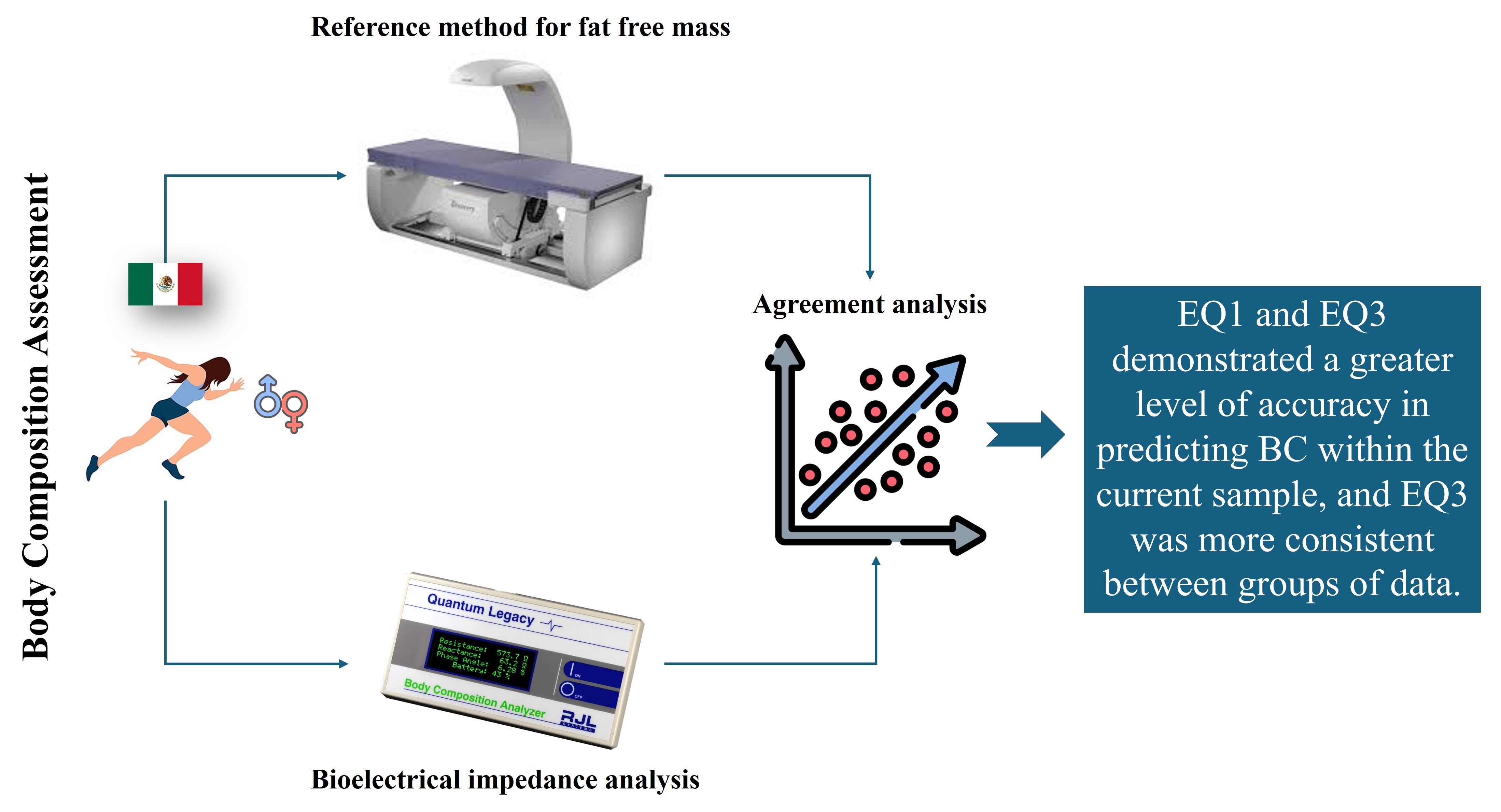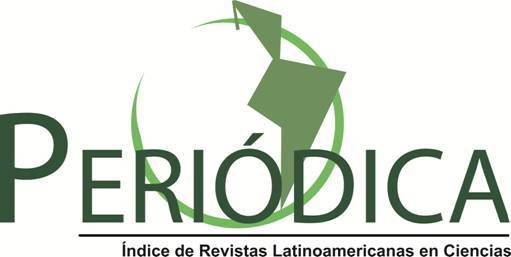External validation of bioelectrical impedance analysis equations for body composition against dual-energy X-ray absorptiometry in Mexican recreational runners
DOI:
https://doi.org/10.18633/biotecnia.v27.2512Keywords:
sport, body fat, athletes, fat-free massAbstract
Sports professionals prioritize athlete body composition (BC) due to its relationship to performance. Bioelectrical impedance analysis (BIA) estimates BC using predictive equations, and validating these equations is essential to determine their utility. The aim of this study was to externally validate four bioelectrical impedance equations for predicting body composition in Mexican recreational runners using dual-energy X-ray absorptiometry (DXA) as a reference method. This external validation pilot study followed a comparative, cross-sectional design and included 30 Mexican male recreational runners (aged 38.0 ± 10.7 years). BC was measured using DXA and four BIA equations. A paired t-test was performed to evaluate differences between methods. Equivalent testing, Simple linear regression, and Bland-Altman analysis were carried out to evaluate agreement between methods. Statistical significance was set at p < 0.05. Non-significant differences were found between DXA and predicted values with Macias et al. (2007) and Lukaski and Bolonchuk (1987) equations (p < 0.05). These equations provided equivalence at 5% regions and non-significant bias. In conclusion, Lukaski and Bolonchuk (1987) demonstrate the most accurate equations for the current sample. These equations showed promising results for measuring BC in a cohort of runners; however, caution is advised when applying them to individual tracking.
Downloads
References
Atkinson, G. and Nevill, A.M. 1998. Statistical Methods For Assessing Measurement Error (Reliabil-ity.in Variables Relevant to Sports Medicine. Sports Medicine, 26(4): 217–238. https://doi.org/10.2165/00007256-199826040-00002.
Bland, J.M. and Altman, D.G. 1986. Statistical methods for assesing agreement between two methods of clinical measurement. Lancet, 1(8476): 307–310.
Bossingham, M.J., Carnell, N.S. and Campbell, W.W. 2005. Water balance, hydration status, and fat-free mass hydration in younger and older adults. Am J Clin Nutr, 81(6): 1342–1350. https://doi.org/10.1093/ajcn/81.6.1342.
Campa, F. et al. 2019. Anthropometry, Physical and Movement Features, and Repeated-sprint Ability in Soccer Players. International Journal of Sports Medicine, 40(2): 100–109. https://doi.org/10.1055/a-0781-2473.
Campa, F. et al. 2021. Assessment of body composition in athletes: A narrative review of available methods with special reference to quantitative and qualitative bioimpedance analysis. Nutrients, 13(5). https://doi.org/10.3390/nu13051620.
Campa, F. et al. 2022. Bioelectrical impedance analysis versus reference methods in the assessment of body composition in athletes. European Journal of Applied Physiology, 122(3): 561–589. https://doi.org/10.1007/s00421-021-04879-y.
Carbuhn, A.F. et al. 2022. Anthropometric Factors Associated With Bone Stress Injuries in Collegiate Distance Runners: New Risk Metrics and Screening Tools?. Orthopaedic Journal of Sports Medicine, 10(2): 1–10. https://doi.org/10.1177/23259671211070308.
Cholewa, J.M. et al. 2019. Anthropometrical Determinants of deadlift Variant Performance. Journal of Sports Science and Medicine, 18(August): 448–453.
Coratella, G. et al. 2021. Generalized bioelectric impedance-based equations underestimate body fluids in athletes. Scandinavian Journal of Medicine and Science in Sports, 31(11): 2123–2132. https://doi.org/10.1111/sms.14033.
Dixon, P.M. et al. 2018. A Primer on the Use of Equivalence Testing for Evaluating Measurement Agreement. Medicine & Science in Sports & Exercise, 50(4): 837–845. https://doi.org/10.1249/MSS.0000000000001481.
Ferland, P.-M., Laurier, A. and Comtois, A.S. 2020. Relationships Between Anthropometry and Maximal Strength in Male Classic Powerlifters.. International journal of exercise science, 13(4): 1512–1531.
Gallagher, D. et al. 2000. Healthy percentage body fat ranges: an approach for developing guidelines based on body mass index. The American Journal of Clinical Nutrition, 72(3): 694–701. https://doi.org/10.1093/ajcn/72.3.694.
Gavan, J.A. 1950. The consistency of anthropometric measurements. American Journal of Physical Anthropology, 8(4): 417–426. https://doi.org/10.1002/ajpa.1330080414.
Giavarina, D. 2015. Understanding Bland Altman analysis. Biochemia Medica, 25(2): 141–151. https://doi.org/10.11613/BM.2015.015.
Houtkooper, L.B. et al. 2001. Body composition profiles of elite American heptathletes. International Journal of Sport Nutrition, 11(2): 162–173. https://doi.org/10.1123/ijsnem.11.2.162.
Knechtle, B. and Tanda, G. 2013. Marathon performance in relation to body fat percentage and train-ing indices in recreational male runners. Open Access Journal of Sports Medicine, p. 141. https://doi.org/10.2147/oajsm.s44945.
Kyle, U.G. et al. 2004. Bioelectrical impedance analysis - Part I: Review of principles and methods. Clin Nutr, 23(5): 1226–1243. https://doi.org/10.1016/j.clnu.2004.06.004.
Lohman, T.G. and Chen, Z. 2005. Dual-Energy X-Ray Absorptiometry. in Human Body Composition. Second. Champaing, IL: Human Kinetics: 63–78.
Lukaski, H.C. et al. 1986. Theory and Validation of the Tetrapolar Bioelectrical Impedance Method to Assess Human Body Composition. Journal of Applied Physiology, 60(4): 1327–1332. https://doi.org/10.1152/jappl.1986.60.4.1327.
Lukaski, H.C. et al. 1990. Body composition assessment of athletes using bioelectrical impedance measurements. J Sports Med Phys Fitness, 30(4): 434–440.
Macias, N. et al. 2007. Body fat measurement by bioelectrical impedance and air displacement ple-thysmography: A cross-validation study to design bioelectrical impedance equations in Mexican adults. Nu-trition Journal, 6. https://doi.org/10.1186/1475-2891-6-18.
Matias, C.N. et al. 2016. Estimation of total body water and extracellular water with bioimpedance in athletes: A need for athlete-specific prediction models. Clin Nutr, 35(2): 468–474. https://doi.org/10.1016/j.clnu.2015.03.013.
Matias, C.N. et al. 2020. Fat-free Mass Bioelectrical Impedance Analysis Predictive Equation for Athletes using a 4-Compartment Model. International Journal of Sports Medicine, 42(1): 27–32. https://doi.org/10.1055/a-1179-6236.
Mooses, M. et al. 2013. Running economy and body composition between competitive and recrea-tional level distance runners. Acta Physiologica Hungarica, 100(3): 340–346. https://doi.org/10.1556/APhysiol.100.2013.3.10.
Nikolaidis, P.T., Rosemann, T. and Knechtle, B. 2020. Skinfold thickness distribution in recreational marathon runners. International Journal of Environmental Research and Public Health, 17(9). https://doi.org/10.3390/ijerph17082978.
Piasecki, J. et al. 2018. The strength of weight-bearing bones is similar in amenorrheic and eumenor-rheic elite long-distance runners. Scandinavian Journal of Medicine and Science in Sports, 28(5): 1559–1568.
Sagayama, H. et al. 2020. Evaluation of fat-free mass hydration in athletes and non-athletes. European Journal of Applied Physiology, 120(5): 1179–1188. https://doi.org/10.1007/s00421-020-04356-y.
Santos, D.A. et al. 2010. Accuracy of DXA in estimating body composition changes in elite athletes using a four compartment model as the reference method. Nutrition and Metabolism, 7. https://doi.org/10.1186/1743-7075-7-22.
Suchomel, T.J., Nimphius, S. and Stone, M.H. 2016. The Importance of Muscular Strength in Athlet-ic Performance. Sports Med, 46(10): 1419–1449. https://doi.org/10.1007/s40279-016-0486-0.
Ulijaszek, S.J. and Kerr, D.A. 1999. Anthropometric measurement error and the assessment of nutri-tional status. Brit J Nutr, 82(3): 165–177. https://doi.org/10.1017/S0007114599001348.
Ward, L.C. and Brantlov, S. 2023. Bioimpedance basics and phase angle fundamentals. Reviews in Endocrine and Metabolic Disorders, 24(3): 381–391. https://doi.org/10.1007/s11154-022-09780-3.

Published
How to Cite
Issue
Section
License
Copyright (c) 2025

This work is licensed under a Creative Commons Attribution-NonCommercial-ShareAlike 4.0 International License.
The journal Biotecnia is licensed under the Attribution-NonCommercial-ShareAlike 4.0 International (CC BY-NC-SA 4.0) license.
















_(2).jpg)







